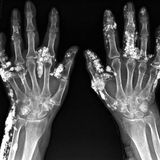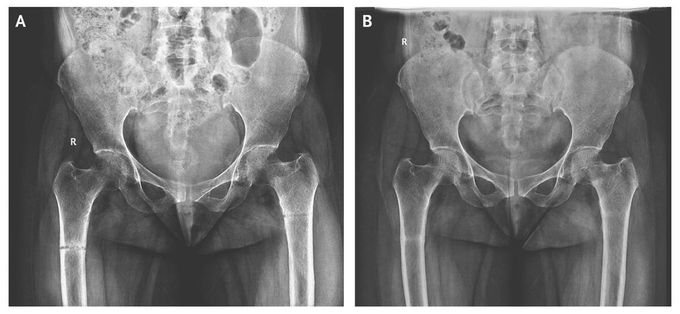


Osteomalacia
A 45-year-old woman presented with a 3-month history of generalized body pains that were nonresponsive to analgesic agents. Along with low back pain, she had progressive difficulty in getting up from sitting and supine positions and in walking. There was no history of trauma or any medication intake. She is an orthodox Muslim woman who wears a black veil outdoors and is completely covered, with little exposure to the sun, even in her courtyard. On examination, she had a waddling gait with painful movements of both thighs. The serum calcium level was 8.4 mg per deciliter (2.1 mmol per liter) (reference range, 8.0 to 10.4 mg per deciliter [2.0 to 2.6 mmol per liter]), the phosphate level 1.5 mg per deciliter (0.5 mmol per liter) (reference range, 2.5 to 4.5 mg per deciliter [0.8 to 1.5 mmol per liter]), the alkaline phosphatase level 916 U per liter (reference range, 30 to 120), and the 25-hydroxyvitamin D level 9 nmol per liter (reference range, 18 to 100). An anteroposterior radiograph of the pelvis showed an undisplaced transverse fracture of the shaft of both femurs (Panel A). The patient was treated with therapeutic doses of calcium and vitamin D supplements. After 3 weeks, her symptoms had improved substantially, and she walked with minimal pain. Blood tests showed an increase in the phosphate level to 3.0 mg per deciliter (1.0 mmol per liter) and a decrease in the alkaline phosphatase level to 418 U per liter. A follow-up radiograph showed healed fractures (Panel B). Patients with osteomalacia may present with generalized osteopenia. A radiographic study may show cortical stress fractures, often called Looser zones or pseudofractures, which are seen as bilateral, symmetric, radiolucent lines in the bone cortex perpendicular to the long axis. Looser zones contain fibrous tissue and poorly mineralized callus and are often found on the ribs, the femoral neck, the pubic rami, and the axillary margins of the scapulae. Vaishali Tomar, M.D. Vijaya Medical Centre, Visakhapatnam, India Vishnu V. Reddy Munagala, M.D. Vizag Rheumatology and Immunology Centre, Visakhapatnam, India Source: nejm.org

